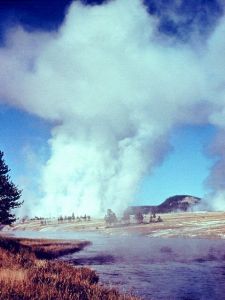by Larry
December, 2003The Big BangWhen my parents, Julia and Leon, took a trip to Yellowstone National Park, about 1972, they wound up being able to spend only one day there due to a recent cold snap and snow storm plus Dad's illness. Nonetheless they experienced something few park visitors can claim for even much longer visits, being on hand when one of Yellowstone's inactive geysers came to life again for the first time in several decades. The park rangers were quite excited and scrambling to properly document this unusual event.
It turns out that the geology of the Yellowstone area owes its peculiar features to volcanic activity, but not to just any run of the mill volcanism. Rather, Yellowstone has had a series of monster eruptions, the largest of which was one of the biggest detonations in the earth's relatively recent (just 2,000,000 years ago) past. This big bang was so huge that if one were to assume the material blasted out of the largest volcanic explosion of historic times, that of Krakatau in Indonesia in 1883, were the size of a golf ball and that ejected from Mount St. Helens were then the size of a pea, the ejecta from this first of Yellowstone's last three super eruptions would be a sphere roughly large enough to conceal someone standing behind it. Although this caldera blast was just one of about a hundred volcanic blows at Yellowstone in the last 16½ million years, there was nothing commonplace about it. The ash from that one eruption would have been sufficient to bury all of New York State to a depth of sixty-seven feet, a bit more debris than had to be cleaned up after 9/11/01.
Even just the last, most recent, but much smaller, Yellowstone eruption (a mere 630,000 years ago), while not to such depths, buried at least some of what are now nineteen states in the western U.S. as well as parts of Canada and Mexico.
Blasts of this size usually are also associated with extensive climatic change, starting with several years of the volcanic equivalent of "nuclear winter." These facts about Yellowstone have a more personal, not simply intellectual, concern for folks traveling there when one realizes that the eruptions in that region occur on average every 165,000 years, with the super volcanic blasts transforming western North America in cycles averaging 600,000 years apart. Since the cycles do not occur with great regularity, it is incorrect to say we are "overdue" for another gigantic explosive release, but it has been a little longer than usual since the last extensive upheaval.
It is interesting to imagine what it would be like to be within that caldera at the moment of its next mammoth outburst. There is just a small chance Julia, Val, and I shall find out next September. Material for many tens of miles across is often blown into the upper atmosphere by such phenomenal paroxysms. Should this occur, we might be the lucky ones. But if our heirs survive the prolonged volcanic winter that would probably follow the next Yellowstone big bang, they would at least be spared the expense of our cremation.
Source: Bill Bryson, A Short History of Nearly Everything (New York, NY: Random House, 2003), pp. 224-235. |
 Now that Julia plans to go back there, in September, 2004, this time with Valerie and me, we have no expectations of a similarly dramatic encounter. But we do hope to appreciate the adventure to the fullest. To this end, we have been researching a little the background of the place. And, indeed, this makes for rather interesting reading.
Now that Julia plans to go back there, in September, 2004, this time with Valerie and me, we have no expectations of a similarly dramatic encounter. But we do hope to appreciate the adventure to the fullest. To this end, we have been researching a little the background of the place. And, indeed, this makes for rather interesting reading.
